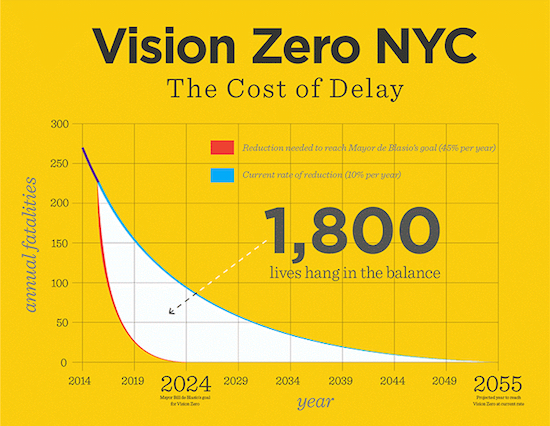Vision Zero working, but needs yearly benchmarks, greater investment
TransAlt Report Card: Fatalities Down, but at Current Pace, NYC Won’t Reach Goal Until 2055

Vision Zero is working, with the number of traffic deaths at historic lows, thanks to Mayor Bill de Blasio’s leadership. That’s the good news. Unfortunately, fatality numbers aren’t falling fast enough to get to zero by 2024, and the city is at risk of being more than 30 years behind schedule.
That’s according to Transportation Alternatives’ 2015 Report Card, which found that progress remained dangerously uneven in the second year of the initiative to eliminate traffic deaths and serious injuries. The advocacy group’s study highlights continuing inconsistency among city and state agencies and calls on the Mayor’s Vision Zero Task Force to adopt annual, measurable benchmarks to evaluate traffic safety efforts.
Paul Steely White, executive director of Transportation Alternatives, said, “The number of traffic fatalities continues to drop because of the de Blasio administration’s commitment to the three E’s of Vision Zero: Engineering to fix dangerous corridors, Enforcement to deter the most deadly driving behavior and Education to change the culture of recklessness on our streets. The mayor has renewed his commitment to get to zero by 2024. But if we’re going to save enough lives each year to meet that goal, the agencies on the Vision Zero Task Force need to commit to another E — evaluation. They must set annual benchmarks to measure progress, and make adjustments to their policies and budgets if they are falling short.”
TransAlt researchers found that if traffic deaths and serious injuries continue to fall at the current rate, New York City won’t reach Vision Zero until 2055, and an estimated 1,800 more people will die in traffic. De Blasio is taking a big step in the right direction by pledging more funds for street redesign, which is essential to save more lives each year. At the Department of Transportation’s current pace, it would take 100 years to fix every dangerous corridor. In Albany, state lawmakers must authorize the deployment of more speed cameras around the five boroughs. “Getting Vision Zero back on schedule is a matter of life and death — 1,800 lives, to be exact,” White said.
The report card notes that while a few players are leading innovative traffic safety efforts — especially City Council Transportation Committee Chair Ydanis Rodriguez — most are falling short. Without leadership from their commissioner, precincts of the NYPD (Grade: C-) continue to summons reckless drivers at disparate rates. The Department of Transportation (Grade: B-) has been inconsistent in its still underfunded efforts to fix dangerous streets, too often allowing local community boards to override the recommendations of traffic safety engineers. The Staten Island District Attorney’s Office and the New York State Department of Motor Vehicles, both of which received a grade of F, have largely bowed out of the effort to eliminate traffic deaths.

Brooklyn Boro
View MoreNew York City’s most populous borough, Brooklyn, is home to nearly 2.6 million residents. If Brooklyn were an independent city it would be the fourth largest city in the United States. While Brooklyn has become the epitome of ‘cool and hip’ in recent years, for those that were born here, raised families here and improved communities over the years, Brooklyn has never been ‘uncool’.